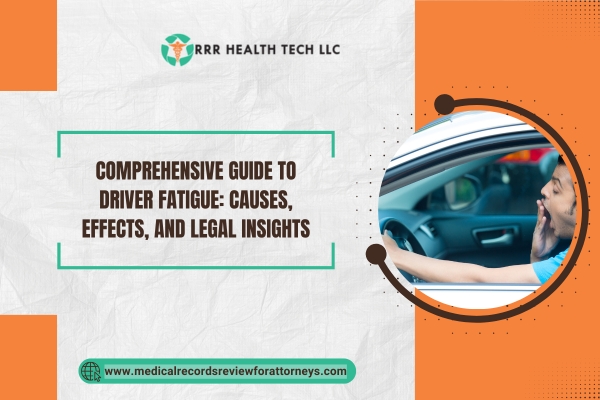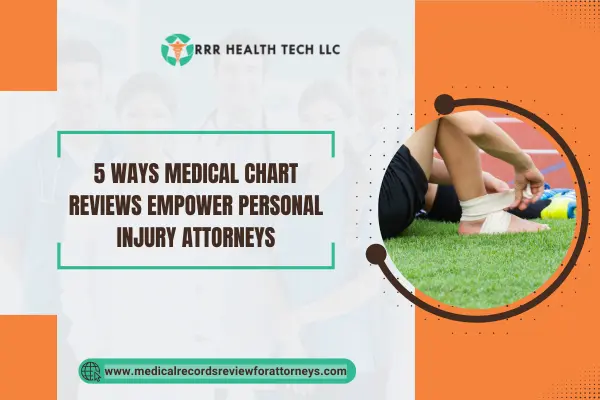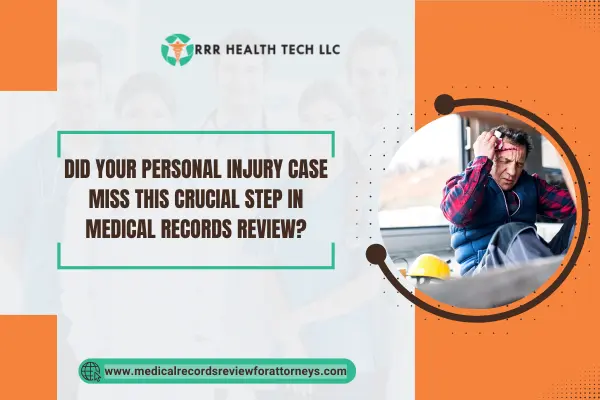
Introduction
As the world has evolved, driver fatigue is a major factor responsible for road accidents and yet very few consider the implications. With modernism permeating throughout society, there exist drivers who find themselves operating a vehicle while drowsy or fatigued. This leads to very dangerous scenarios. This guide highlights the causes and effects of driver fatigue, legal consequences one may face due to it, and how a medical records review can prove useful for lawyers working on personal injury cases due to drowsy driving.
Understanding Driver Fatigue
What is Driver Fatigue?
Fatigue is being too physically and mentally exhausted that exercising the ability to drive results in danger. This can stem from many different aspects such as free from sleep, long hours of driving, fatigue, and any other underlying medical issues.
Causes of Driver Fatigue
- Sleep Deprivation- According to NHTSA, the lack of requisite sleep is by far the most common reason behind driver fatigue. Adults require an accurate amount of sleep to function, which is roughly 7-9 hours. The United States National Highway Traffic Safety Administration claims sleep related vehicular accidents are primarily caused due to daylight sleepiness.
- Long Driving Hours- Driving for long durations without pausing can impact one’s mental state and result in fatigue. One of the negative consequences of operating vehicles for long durations is increased tiredness brought out as a result of prolonged focus and stress caused by intense traffic.
- Medical Conditions: Some medical conditions like sleep apnea, narcolepsy, and chronic fatigue syndrome are likely to heighten the severity of driver fatigue.
- Medication: Certain prescribed medication can lead to patients being drowsy, which can hinder their alertness as a driver.
- Alcohol and Substance Use: Consuming alcohol and recreational drugs are likely to worsen fatigue and hinder one’s ability to operate a vehicle proficiently.
Recognizing the Signs of Driver Fatigue
Understanding the signs of driver fatigue is crucial for preventing accidents. Common symptoms include:
• Excessive Yawning
• Problems with concentration
• Blinking of eyelids frequently
• Feeling annoyed
• Sluggish action response
The Consequences of Driver Fatigue
Impact on Road Safety
Driver fatigue is a huge contributor to road accidents which without a doubt cause severe injuries and even fatalities. The statistics from National Safety Council (NSC) state that drowsy driving contributes to around 100,000 road crashes every year in the United States alone, which contributes to thousands of injuries and deaths.
Legal Consequence
Legal consequences arise from accidents caused by driver’s fatigue. The victims tend to claim compensation for medical costs, lost income, and trauma. Lawyers are critical in these types of casework and often depend on the medical records review to determine the level of injury and if fatigue was a factor in the accident.
The Role of Medical Records Review in Fatigue-Related Cases
Importance of Medical Records
Medical records provide essential documentation of a victim’s injuries and treatment history. In cases involving driver fatigue, these records can help establish:
- Causation: Accurately showing that the injuries received were due to the specific accident.
- Injuries Severity: Validating proof that the claimant was indeed injured and that medical attention was required.
- Future Effect: Show any possible enduring consequences of the obtained injuries, if any, which could determine the compensation amount.
How Medical Records Review Supports Attorneys
- Building a strong case – Let’s assume that an attorney possesses a medical reviewer, who is board certified in occupational medicine, will assist them in constructing quite the compelling case review of the victim’s treatment will certainly enhance the attorney’s argument.
- Distinguishing Cases: Records are helpful in revealing attempts to cope with fatigue which became contributory to the accident.
- Expert Testimony: Legal practitioners may refer to medical documents as a source of expert testimony on how fatigue affects an individual’s driving capabilities.
Preventing Driver Fatigue
Tips for Drivers
- Sleep Well: The night before a long trip make sure to get enough sleep, which should be at least 7-9 hours.
- Rest: Plan to take regular rest stops on long trips.
- Stay Hydrated and Nourished: Consume water and healthy snacks to sustain your energy.
- Stay Away from Alcohol and Sedating Medications: Do not consume alcohol and medications that cause sleepiness before driving.
- Use Technology Reasonably: Employ applications and devices that will alert you when you are becoming tired.
Case Studies
Case Study 1: Commercial Truck Driver Fatigue
Overview: A commercial truck driver caused a multi-vehicle accident after taking a nap at the wheel. He worked for 14 hours straight without any breaks.
Challenges: The trucking company attempts to blame the other drivers involved and accuses them of not keeping a safe distance from each other.
Solutions: A thorough review of the medical records highlighted chronic sleep deprivation along with absence of rest breaks of the driver, which were very helpful in proving the liability of the trucking company for failing to provide adequate rest breaks.
Case Study 2: Drowsy Driving Incident
Overview: A young driver suffered from a motor vehicle accident after he dozed off while going back home from night shift work since he was too overtired to drive and crashed head on with another car.
Challenges: The insurance provider refuted the claim at the outset, on the basis of an error that the driver should not have operated the car in her present level of extreme exhaustion.
Solutions: The lawyer performed an extensive review of the driver’s records that in parts included medical documents highlighting the presence of a disorder that leads to excessive daytime drowsiness which made it easy to support the claim. This evidence helped to illustrate that the driver could not appreciate the level of impairment they had while operating the vehicle.
Conclusion
Addressing driver fatigue is of utmost importance if there is a desire to promote safety on the roads and reduce the number of accidents caused by drowsy driving. Removing the danger of road accidents can be achieved by implementing preventive measures that detect fatigue’s crucial indicators and legal ramifications of fatigue induced accidents. Moreover, a review of medical records is critical in assisting attorneys who handle personal injury cases to guarantee that the victims get justice. By understanding the information in this guide, people can manage the issues surrounding driver fatigue and its impacts more effectively.”


